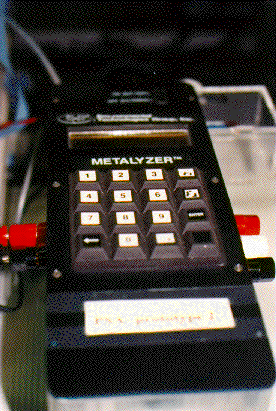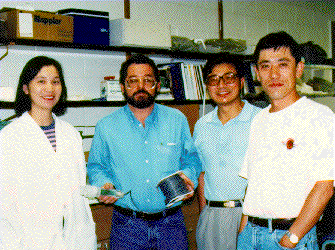

The microorganism Cryptosporidium parvum is recognized as a serious public health threat. Infections with this protozoan can lead to acute gastroenteritis and diarrhea that can become life threatening in individuals with weakened immune systems. A highly publicized example of an outbreak occurred in Milwaukee in 1993, in which the microbe infected over 400,000 people and contributed to 104 deaths.
New Mexico State University chemist Joseph Wang received a Seed Money Research grant from the WRRI in 1997 to attempt to develop a reliable, cost-effective, compact bioanalytical device for rapid monitoring of Cryptosporidium parvum, based on the combination of highly specific DNA hybridization biosensors and a microfabricated PCR (Polymerase Chain Reaction) reactor.
The biosensor hybridization reactions were monitored by Dr. Wang’s state-of-the-art miniaturized electrochemical transducers, which by themselves can enable extremely low pathogen detection limits. To push the sensitivity still further, to the striking level of just a few Cryptosporidium parasites in a water sample, the biosensors are being integrated with a PCR amplification unit, all on a single chip, in an effort to obtain the advantages of simultaneous in situ amplification and detection eventually in a single hand-held unit.
During the tenure of this project, Dr. Wang and his team of researchers developed several novel electrical detection schemes for detecting DNA sequences specific to Cryptosporidium parvum, and have reported their findings in several major international journals. Dr. Wang’s WRRI project will end this summer and he will report his findings in a WRRI technical completion report, which should be ready for distribution the following spring.
The WRRI would like to congratulate Dr. Wang on being selected by the American Chemical Society’s Division of Analytical Chemistry as the 1999 winner of its Chemical Instrumentation Award. This award is given only to one chemist each year, and will be presented at the ACS meeting in August. A two-day analytical chemistry symposium in Wang’s honor, featuring presentations by 12 of the leading scientists in the field, will be held as part of the ACS conference.
Besides detecting microorganisms in water, Dr. Wang’s hand-held sensors can be used for a variety of other purposes such as the detection of lead in blood and the measurement of glucose levels in diabetics.
Dr. Wang’s prolific career includes six patents, five books, 15 chapters and more than 450 research papers. He has presented more than 100 invited lectures at major international conferences. Since 1980, 15 doctoral students, 30 research associates and 20 visiting professors from around the world have studied with Wang and worked in his NMSU laboratory.
“Dr. Wang has been one of the giants in the New Mexico State University research effort for quite some time, and this fact is well known by his colleagues on campus,” said Rene Casillas, dean of arts and sciences at NMSU. “This prestigious award, the American Chemical Society’s highest award for analytical chemists, signifies that the international community has long recognized his important contributions.”
